India Packaging Market Size
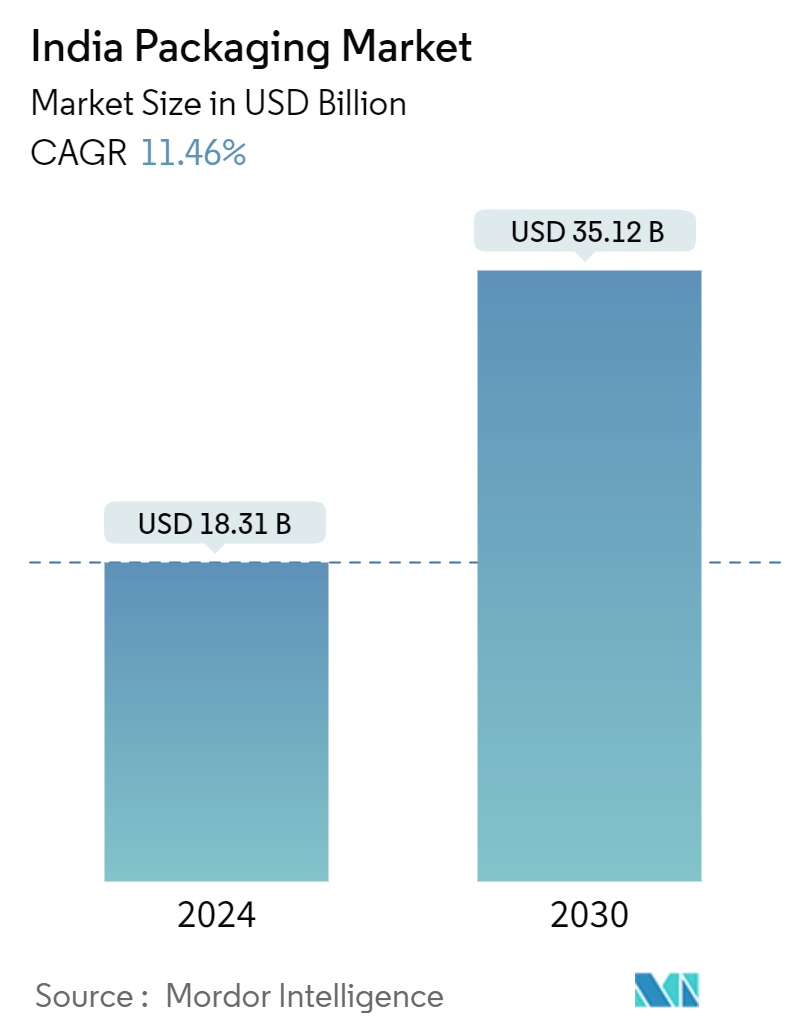
| Study Period | 2019 - 2030 |
| Base Year For Estimation | 2023 |
| Market Size (2024) | USD 18.31 Billion |
| Market Size (2030) | USD 35.12 Billion |
| CAGR (2024 - 2030) | 11.46 % |
| Market Concentration | Medium |
Major Players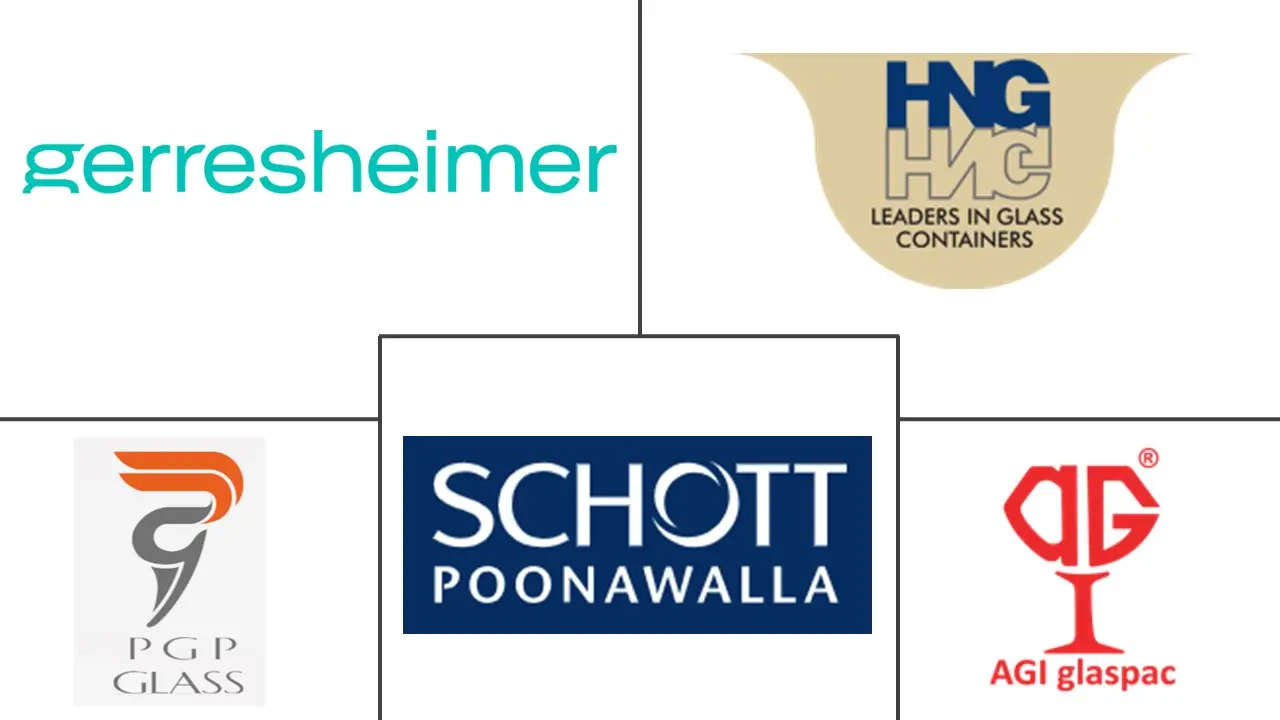
*Disclaimer: Major Players sorted in no particular order |
India Packaging Market Analysis
The India Packaging Market size is estimated at USD 18.31 billion in 2024, and is expected to reach USD 35.12 billion by 2030, growing at a CAGR of 11.46% during the forecast period (2024-2030).
Technological advancements and rising consumer awareness have favorably positioned the Indian packaging sector. The country's abundant raw materials and a significant increase in per capita spending, especially in rural and middle-class segments, are reshaping market demands. Innovations like aseptic, retort, and biodegradable packaging enhance food product longevity.
- An industry expert from the flexible packaging sector further highlights that local manufacturers are thriving in the face of high packaging demand in India. Leading FMCG firms opt for multiple vendors, favoring local vendors for their agility in decision-making and competitive pricing in the country. The flexible packaging industry in India is largely self-reliant, with minimal dependence on imports. Small entrepreneurs and privately owned companies are driving growth and innovation, becoming key players in the market.
- India's packaging sector, riding on a strong historical growth trajectory, is steadily converging with global benchmarks. With promising prospects from the retail and e-retail segments, the industry's evolution is poised to favor organized entities, sidelining smaller, less equipped players. Driven by heightened demand from sectors like e-commerce, FMCG, food and beverages, household products, and white goods, India's carton industry is witnessing a notable upswing.
- India's recent packaging regulations go a step further, banning the use of recycled plastics in food packaging and prohibiting newspapers and other materials for packing or wrapping food items. These regulations also specify Indian Standards for printing inks used on food packages. Schedule IV of these regulations outlines recommended packaging materials for various food product categories.
- Flexible plastic packaging dominates India's plastic packaging landscape, accounting for three-quarters of the total usage. The FMCG sector favors this type of packaging for its versatility and cost-effectiveness. The prevalent multi-layered packaging, often produced by small-scale manufacturers prioritizing cost, leads to a diverse range of non-recyclable flexible packaging compositions entering the market.
- The growing rate of urbanization across the country has bolstered the focus on convenient and sustainable packaging. With end-users like fresh food, ready-to-eat meals, pet food, and coffee showing robust growth, the demand for pouch packaging is set to surge. According to a report by BDO India, a prominent management consulting firm, India's ready-to-cook food market is projected to reach INR 64 billion (approximately USD 0.76 billion) by 2025, marking a significant increase from its 2020 valuation of INR 30 billion (about USD 0.35 billion). This growth in ready-to-eat meal packages is anticipated to surge the demand for flexible packaging in the forecast period.
India Packaging Market Trends
Food Industry is Expected to Hold the Largest Share in the Market
- Consumers increasingly turn to nutrient-dense dairy products like cheese, milk, and yogurt, seeking heightened nutrition. These products have a longstanding reputation for being rich in vitamins, proteins, and easily absorbable calcium. The presence of numerous biologically functional components bolsters the dairy products segment's outlook for the forecast period.
- In 2023, India emerged as the largest consumer of cow milk globally, with a consumption exceeding 87 million metric tons, as the USDA Foreign Agricultural Service reported. India's dairy sector boasts diverse products, including ghee, butter, lassi, and paneer. Notably, curd and yogurt stand out as the most lucrative segments.
- Flexible packaging, favored by consumers and producers of baked goods and snacks, offers unparalleled convenience. Consumers value its resealability and user-friendly nature, especially for products like cookies and bread, which are commonly enjoyed over multiple sittings.
- According to a survey conducted by LocalCircles, a social research firm, in November 2023, with 10,939 respondents spanning 222 districts in India, a significant majority of respondents reported daily consumption of bakery products. Films play a pivotal role in driving the surge of flexible bakery packaging. They safeguard bulk-packaged bakery items, meeting the rising consumer appetite. Lightweight and adept at ensuring safe deliveries, bakery flexible packaging, especially films, enhances product visibility, propelling the sector's growth.
- Flexible packaging for frozen foods must ensure top-tier product safety from production to consumption. These materials are tailored to withstand extreme cold, ensuring the integrity of the packaging. The rising consumption of frozen fish, chicken, and other meats drives the demand for packaging materials. Flexible packaging, favored for its ability to shield against contaminants, preserve freshness, and provide convenient storage, is particularly well-suited for meat products.
- According to data from the Ministry of Commerce & Industry, in June 2023, frozen fish emerged as a leading export, raking in INR 5,503.18 crore (USD 687.05 million). Notably, a significant surge in frozen fish exports was observed in 2023. Quantities rose by 62.65%, while INR and USD values climbed by 58.51% and 45.73%, respectively. The growth in frozen fish exports would bolster the demand for several flexible packaging formats across the country in the coming years.
- With India witnessing a notable surge in milk production and consumption, the demand for flexible packaging in the dairy industry has soared. These solutions are tailored to meet the specific needs of the dairy sector, offering robust advantages. According to the USDA Foreign Agricultural Service, in 2023, India's domestic milk consumption surpassed 207 million metric tons, which rose from the previous year's 202 million metric tons. This growing trend is expected to continue in the upcoming years, contributing to the demand for flexible dairy pouches, films, and other products across the country.
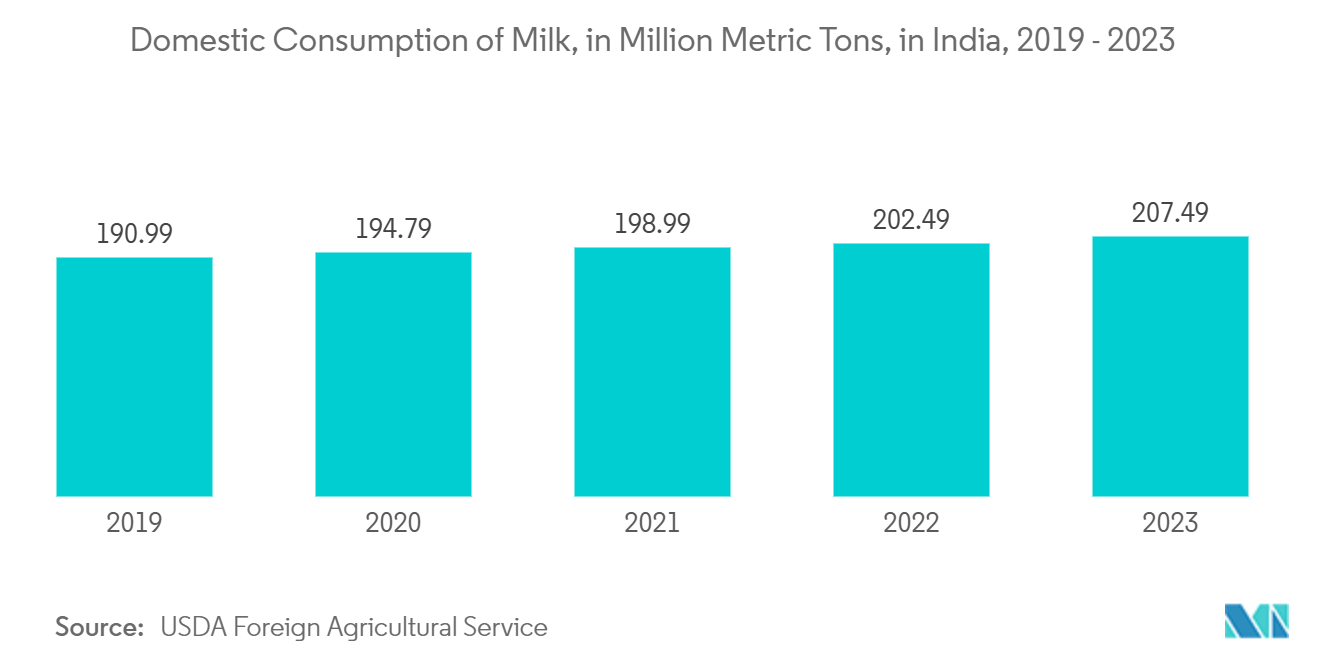
Paper Packaging is Expected to Hold Significant Market Share
- The environmental advantages of paper packaging are the primary drivers behind the expanding market for paper flexible packaging. Paper packaging, known for its lightweight, biodegradable, and recyclable nature, provides a flexible and cost-effective means of transporting, preserving, and safeguarding products and plays a pivotal role in the growth of the flexible packaging industry. According to the Department of Commerce (India), during the financial year 2023, India's paper and paperboard product exports reached a valuation of around 3.04 billion U.S. dollars.
- Over the past decade, the Indian paper packaging sector has seen significant growth, attributed to shifts in substrate preferences, the penetration of new markets, evolving ownership structures, and governmental initiatives aimed at curbing plastic usage. The segment is poised for further growth with a continued emphasis on sustainability and environmental concerns, coupled with a wave of innovations in paper packaging.
- The Indian flexible packaging sector utilizes paper in various forms, such as bags, sachets, and wraps. The rising demand for more miniature packs has propelled the flexible pouch market, known for its small-quantity packaging. Compared to traditional packaging, flexible paper packaging stands out for its cost-effectiveness, minimal material requirement, and lightweight nature. Its efficiency and affordability have significantly boosted the popularity of flexible paper packaging.
- According to Indian Pulp & Paper Technical Association (IPPTA), the Indian Paper Industry accounts for 1.6% of the world’s paper and paperboard production. The industry’s turnover is expected to touch the 60,000 mark by 2025.
- According to IBEF, India has 861 paper mills, 526 of which are currently operational. Collectively, they have an installed capacity of 27.15 million tons. From April 2000 to December 2023, the Paper and Pulp sector, encompassing paper products, attracted FDI inflows totaling USD 1.7 billion.
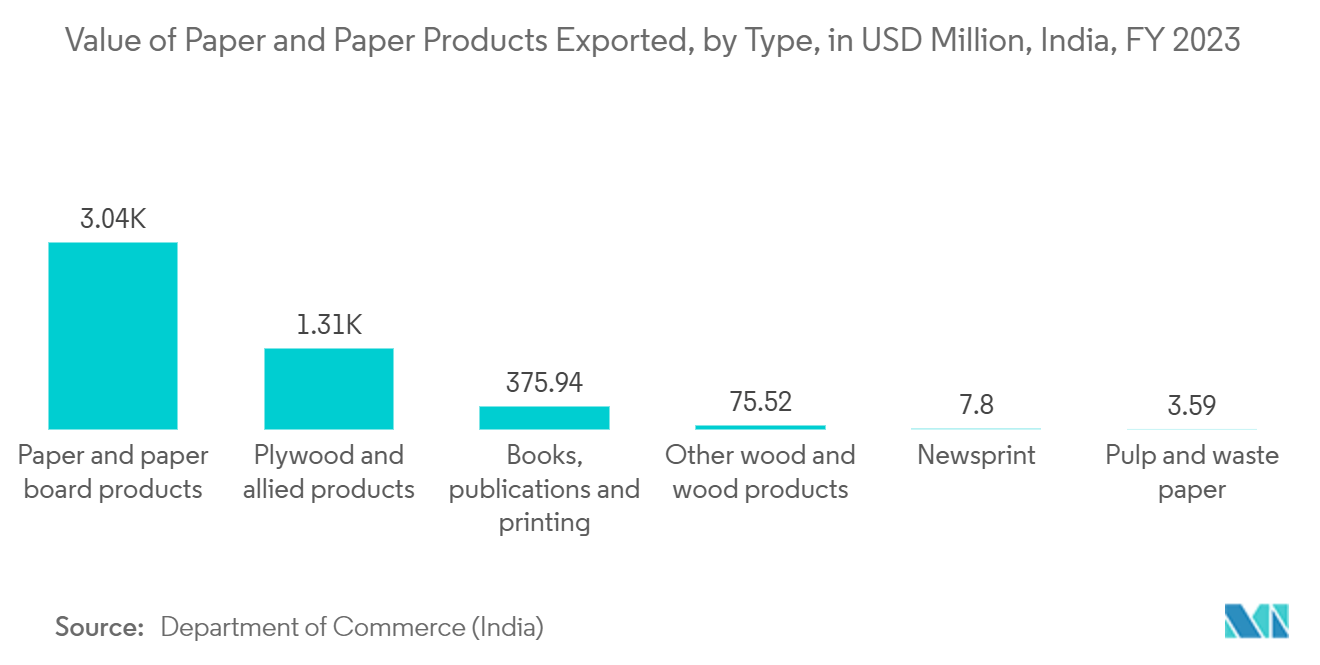
India Packaging Industry Overview
The Indian Packaging market is semi-consolidated with the presence of major players like Schott Poonawalla Private Limited, Gerresheimer AG, Agi Glaspac (HSIL Limited), PGP Glass Private Limited (Piramal Glass), and Hindustan National Glass & Industries Limited (HNGIL). Players in the market are adopting strategies such as partnerships and acquisitions to enhance their product offerings and gain sustainable competitive advantage.
- May 2024 - TCPL announced its intention to set up a new greenfield facility in Southern India. This move is not just about expanding its footprint; it is a strategic leap to bolster its Pan-India presence. The facility, strategically situated near Chennai, enjoys proximity to major industrial hubs, offering unparalleled logistical advantages and direct access to core markets.
- April 2024 - Sabar Dairy, a prominent dairy cooperative, and Tetra Pak joined forces in a collaboration aimed at enhancing sustainability within the dairy sector. Their first step involves a pilot project: constructing roofs for a 40-cow shed using polyAl material sourced from recycled beverage cartons. These innovative polyAl sheets were crafted by Eastern Cargo, a long-standing recycling partner of Tetra Pak based in Gujarat. Eastern Cargo has been dedicated to creating roof tiles and flat sheets since 2016.
India Packaging Market Leaders
-
Schott Poonawalla Private Limited
-
Gerresheimer AG
-
Agi Glaspac (HSIL Limited)
-
PGP Glass Private Limited (Piramal Glass)
-
Hindustan National Glass & Industries Limited (HNGIL)
*Disclaimer: Major Players sorted in no particular order
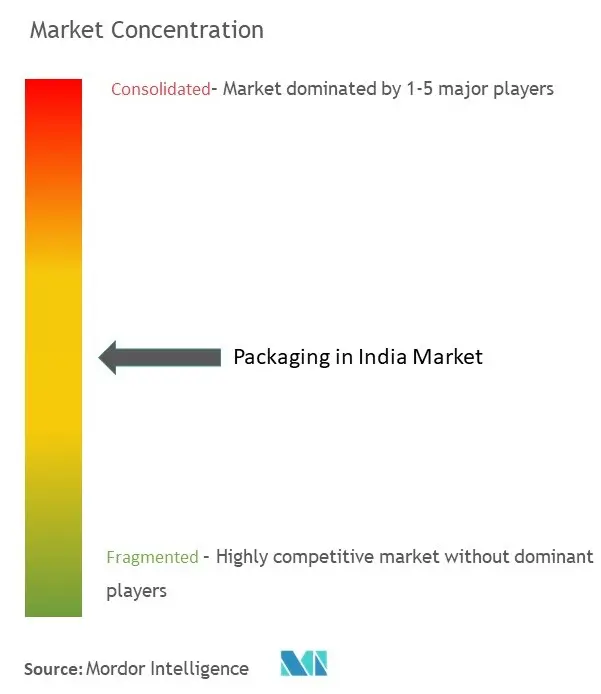
India Packaging Market News
- March 2024: Nestle India launched a new line of frozen flexible food packets under the brand Maggi called 'Nutri-Licious.' The range includes veggie kebabs, Achari pockets, and Special Veggie pouches. Flexible pouches, especially stand-up pouches, are witnessing rapid adoption in the burgeoning food industry. Suppliers are embracing this packaging trend and, therefore, expanding production.
- March 2024: Toppan, a prominent global printing and packaging solutions provider, unveiled GL-SP, a cutting-edge barrier film designed for sustainable packaging, set to debut in India. Developed in partnership with India's TOPPAN Specialty Films (TSF), this pioneering product is anchored on biaxially oriented polypropylene (BOPP) as its core material. Mono-material packaging, which utilizes a single material type, is increasingly popular due to its recycling-friendly nature.
India Packaging Market Report - Table of Contents
1. INTRODUCTION
1.1 Study Assumptions and Market Definition
1.2 Scope of the Study
2. RESEARCH METHODOLOGY
3. EXECUTIVE SUMMARY
4. PACKAGING INDUSTRY OVERVIEW IN INDIA
4.1 Market Overview
4.2 Composition of Packaging Sector in India - Analysis of Establishments
4.3 End-user Analysis
4.4 Analysis of the Share of Imports in the Packaging Sector (Historical and Current)
4.5 Market Ecosystem Analysis
5. SECTORAL PERFORMANCE AND MARKET ENTRY PARAMETERS
5.1 Analysis of Key Economic Indicators and Trade Flows w.r.t. Packaging Industry in India
5.2 Analysis of the Key Foreign Investments in the Packaging Sector in India
5.3 Trade Scenario Analysis - Coverage of the Key Packaging Products Based on the Relevant hs Codes
5.4 Routes to Entry into the Indian Packaging Sector
5.5 Overall Profitability of the Packaging Sector in India
5.6 Key Strategic Imperatives for Prospective Entrants into India
6. MARKET DYNAMICS
6.1 Market Drivers
6.1.1 Rise of the Organized Retail and E-commerce Sector
6.1.2 Increasing Demand for Sustainable and Recyclable Packaging
6.2 Market Challenges
6.2.1 Shortage and Rising Cost of Raw Material
6.2.2 Non-availability of Skilled Manpower
6.3 Focus Toward Development of Intelligent Packaging
6.4 Assessment of the Impact of COVID-19 on the Packaging Industry in India
7. KEY THEMES IN THE PACKAGING INDUSTRY IN INDIA
7.1 Role of E-commerce in Driving the Packaging Sector
7.2 Major Pharmaceutical Packaging Vendors Foraying into India
7.3 Role of Sustainability in the Food and Beverage Packaging Market
7.4 Emergence of Closed-loop Solutions in the Retail Sector
8. MARKET SEGMENTATION
8.1 By Material Type
8.1.1 Plastic
8.1.1.1 Plastic Type - Summary
8.1.1.1.1 Rigid Plastic Packaging
8.1.1.1.2 Flexible Plastic Packaging
8.1.1.2 End-user
8.1.1.2.1 Food
8.1.1.2.2 Beverage
8.1.1.2.3 Cosmetics and Personal Care
8.1.1.2.4 Industrial
8.1.1.2.5 Pharmaceutical and Healthcare
8.1.1.2.6 Other End-users
8.1.2 Paper
8.1.2.1 Paper Type - Summary
8.1.2.1.1 Folding Carton
8.1.2.1.2 Corrugated Boxes
8.1.2.1.3 Paper Bags and Liquid Paperboard
8.1.2.2 End-user
8.1.2.2.1 Food and Beverage
8.1.2.2.2 Retail and E-commerce
8.1.2.2.3 Industrial
8.1.2.2.4 Personal Care & Cosmetics
8.1.2.2.5 Other End-users
8.1.3 Container Glass
8.1.3.1 Container Glass - Summary
8.1.3.2 End-user
8.1.3.2.1 Food
8.1.3.2.2 Beverage
8.1.3.2.2.1 Alcoholic
8.1.3.2.2.2 Non-alcoholic
8.1.3.2.3 Personal Care and Cosmetics
8.1.3.2.4 Healthcare
8.1.4 Metal Cans and Containers
8.1.4.1 Metal Cans and Containers - Summary
8.1.4.2 End-user
8.1.4.2.1 Food
8.1.4.2.2 Beverage
8.1.4.2.3 Paints and Chemicals
8.1.4.2.4 Industrial
8.1.4.2.5 Other End-users
9. COMPETITIVE LANDSCAPE
9.1 Company Profiles
9.1.1 Schott Poonawalla Private Limited
9.1.2 Gerresheimer AG
9.1.3 Agi Glaspac (HSIL Limited)
9.1.4 PGP Glass Private Limited (Piramal Glass)
9.1.5 Hindustan National Glass & Industries Limited (HNGIL)
9.1.6 ITC Limited
9.1.7 JK Paper Ltd
9.1.8 Emami Paper Mills Limited (Emami Group)
9.1.9 Canpac SA
9.1.10 Velpack Pvt. Ltd.
9.1.11 Westrock India
9.1.12 OJI India Packaging Pvt. Ltd.
9.1.13 KCL Limited
9.1.14 Trident Paper Box Industries
9.1.15 Packman Packaging Private Limited
9.1.16 Hitech Plast (Hitech Group)
9.1.17 Schoeller Allibert
9.1.18 Berry Global Inc.
9.1.19 Aptar Group Inc.
9.1.20 Manjushree Technopack Ltd.
9.1.21 Jindal Poly Films Limited
9.1.22 TCPL Packaging Limited
9.1.23 Uflex Limited
9.1.24 Polyplex Corporation Limited
9.1.25 Cosmo Films Ltd. (Cosmo First Limited)
9.1.26 Hindustan Tin Works Ltd.
9.1.27 Ball India (Ball Corporation)
9.1.28 AI Packaging Limited
9.1.29 Zenith Tins Pvt. Ltd.
9.1.30 Kaira can Company Limited
9.1.31 Asepto (Uflex Limited)
9.1.32 Tetra-pak India Private Limited
9.1.33 Megaplast India Pvt. Ltd.
9.1.34 Bag Master
9.1.35 The Bag Smiths
- *List Not Exhaustive
10. CURRENT RECYCLING TRENDS IN INDIA
11. MARKET OUTLOOK
India Packaging Industry Segmentation
Packaging is defined as the process of providing a protective and informative covering to the product such that it protects the product during material handling, storage, and movement and also provides useful information to all the related supply chain partners about the content of the package. Its application can extend from primary, secondary, and tertiary to ancillary packaging.
The Indian packaging market is segmented by material (plastic, paper, container glass, metal can, and container) and end users (food and beverage, retail and e-commerce, paints and chemicals, industrial, personal care and cosmetics, and other end users). The market sizes and forecasts regarding value (USD) for all the above segments are provided.
| By Material Type | ||||||||||||||
| ||||||||||||||
| ||||||||||||||
| ||||||||||||||
|
India Packaging Market Research Faqs
How big is the India Packaging Market?
The India Packaging Market size is expected to reach USD 18.31 billion in 2024 and grow at a CAGR of 11.46% to reach USD 35.12 billion by 2030.
What is the current India Packaging Market size?
In 2024, the India Packaging Market size is expected to reach USD 18.31 billion.
Who are the key players in India Packaging Market?
Schott Poonawalla Private Limited, Gerresheimer AG, Agi Glaspac (HSIL Limited), PGP Glass Private Limited (Piramal Glass) and Hindustan National Glass & Industries Limited (HNGIL) are the major companies operating in the India Packaging Market.
What years does this India Packaging Market cover, and what was the market size in 2023?
In 2023, the India Packaging Market size was estimated at USD 16.21 billion. The report covers the India Packaging Market historical market size for years: 2019, 2020, 2021, 2022 and 2023. The report also forecasts the India Packaging Market size for years: 2024, 2025, 2026, 2027, 2028, 2029 and 2030.
What are the key challenges faced by the Packaging Industry in India?
The key challenges faced by the Packaging Industry in India: a) Fluctuations in raw material prices b) Regulatory compliance regarding food safety and packaging standards, and c) Managing waste generated from packaging
India Packaging Industry Report
The India Packaging Market is on a significant growth trajectory, propelled by the e-commerce boom, technological advancements, and changing consumer preferences. This market, embracing materials like plastics, paper, metal, and glass, serves diverse industries such as food processing, pharmaceuticals, and personal care. The e-commerce surge has spiked demand for both rigid and flexible packaging, steering the market towards sustainable solutions. Government initiatives promoting the 'Make in India' policy and technological progress have further fueled growth. The industry is also moving towards innovative packaging that enhances the customer experience, particularly in the food and beverage sector, which dominates the market. With a strong emphasis on sustainability, paper packaging is emerging as a preferred eco-friendly option. Supported by consumer trends, innovation, and government policies, the India Packaging Market is set for ongoing expansion, playing a crucial role in the nation's manufacturing and retail landscapes. For detailed market insights, including share, size, and growth forecasts, ����vlog��ý™ offers a comprehensive analysis and free report PDF download.



